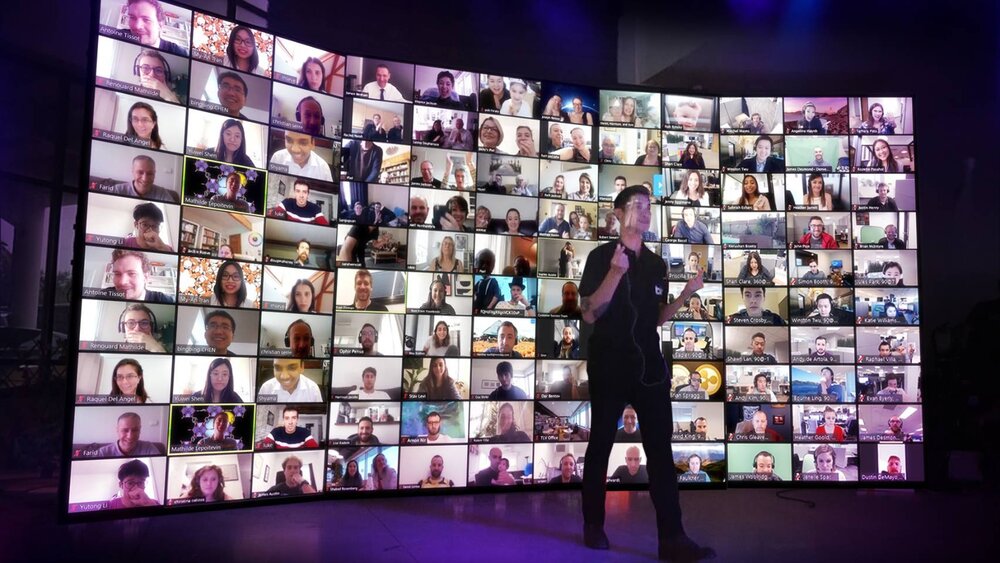The belief that people don’t engage with online content for long periods is a widely held misconception, especially in the realm of virtual events. As a company with many years of experience in running online and hybrid events for large organisations,we’ve encountered this myth repeatedly. However, the reality of audience engagement is far more nuanced, and in many cases, it’s directly tied to the quality of the content being presented.

Understanding the Myth
The myth that people have short attention spans online is pervasive. It’s fueled by studies showing declining attention spans and the idea that digital content must be concise to retain viewers. This belief has influenced how many organisations approach online events, leading them to shorten presentations, simplify content or avoid in-depth discussions. However, this approach overlooks a critical aspect: engagement isn’t solely about duration; it’s about the relevance and quality of the content.
Consider how people consume content in other digital spaces. For example, the average American now spends 115 minutes a day watching online videos. This is not a trivial amount of time, and it suggests that people are willing to engage with content for extended periods when it captures their interest. The key takeaway here is that when you create engaging online content, audiences are more than happy to invest their time.
The Power of Engaging Online Content
Years of experience in virtual and hybrid event production have shown us firsthand how the quality of content can make or break an event. The most successful online events we’ve managed have had one thing in common: they were built around high-quality, compelling content that resonated with the audience.
Quality content in the context of virtual events goes beyond simply having an interesting topic. It involves a combination of factors, including:
Engaging Presentations:
Speakers who can deliver their message with enthusiasm and clarity are crucial. Audiences are more likely to stay engaged when the speaker is dynamic and the presentation is well-structured.
Interactive Elements:
Incorporating interactive elements such as Q&A sessions, polls and breakout rooms can keep the audience actively involved. These elements provide opportunities for the audience to participate rather than passively consume content.
Audio Visual Appeal:
The visual aspect of a virtual event, including slide designs, video quality and the overall aesthetic, plays a significant role in maintaining engagement. High-quality visuals help convey messages more effectively and keep the audience interested.
And the importance of clean, clear audio cannot be understated; bad audio means an uncomfortable experience for the online participant and will drive them away.
Relevance to the Audience:
Understanding your audience’s needs and interests is key to delivering engaging online content that resonates. When it speaks directly to the audience’s challenges or interests, they are far more likely to stay engaged.
These factors contribute to creating a compelling virtual experience that holds the audience’s attention. When done right, these elements can make a virtual event as engaging, if not more so, than an in-person event.
Real-World Examples of Engagement
At BeThere Global, we’ve had the privilege of working on many virtual events that defy the myth of short attention spans.
For example, we regularly provide online educational events for the International Society of Ultrasound in Obstetrics and Gynecology (ISUOG). Their events consist of in-depth lectures, expert panel discussions and interactive Q&A sessions and are notable for their global reach (often attracting participants in 100+ countries). Typically these virtual events will extend over a full 8 hour day.
Despite the extended duration, audience engagement remains high throughout. Attendees are deeply involved in the discussions, ask insightful questions and participate in the interactive sessions. Our statistics show average viewing times are frequently 70+% of the live event’s entire duration, with many more hours of the content consumed by re-visiting on-demand. The continued success of ISUOG’s online educational events is testament to the power of engaging online content in maintaining engagement over long periods.
Another example is a World Congress staged in Istanbul for ISAPS. The program consisted of multiple 3+ hour sessions, over 4 days. Conventional wisdom might suggest that such long sessions would lead to drop-offs in attendance, but the opposite was true. The participants were engaged and motivated, largely because the content was relevant, well-delivered and included opportunities for interaction.
The Future of Online Engagement
As virtual and hybrid events become more commonplace, understanding how to create content that engages audiences for extended periods is crucial. The key to busting the myth of short attention spans lies in focusing on quality. When content is well-crafted, relevant, and engaging, people will not only stay—they’ll be eager for more.
In the future, we can expect to see continued innovation in how virtual events are produced and delivered. Advances in technology, such as virtual reality and AI-driven personalisation, will likely further enhance the ability to create engaging online content that captivates audiences. However, despite technological advances, the core principle remains the same: content is most definitely still the king.
Concluding Thoughts
The myth that people don’t engage with online content for long periods is just that – a myth. In reality, the success of a virtual event hinges on the quality of the content. High-quality, engaging content has the power to captivate audiences for extended periods, whether the event is an online conference, a webinar or a hybrid event. As we move forward in the digital age, understanding and leveraging this truth will be key to creating virtual experiences that truly resonate with audiences.
At BeThere Global, we are committed to delivering exceptional virtual and hybrid events that defy the myths and set new standards for engagement. Our experience shows that with the right approach, engaging online content can be just as successful – if not more so – than traditional in-person events.



